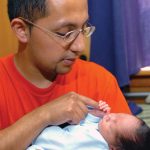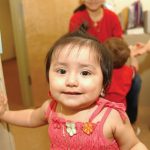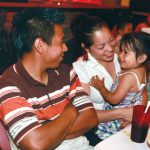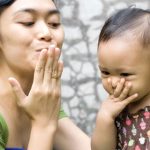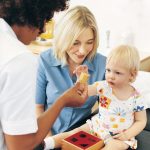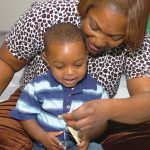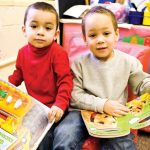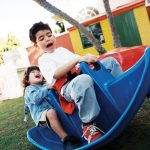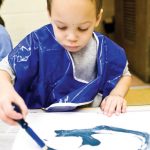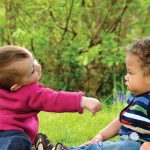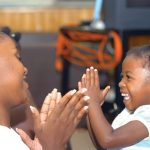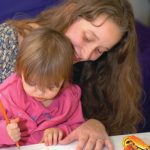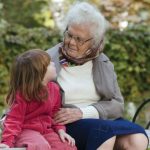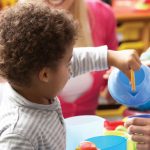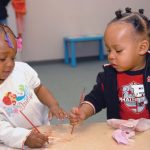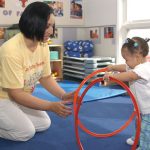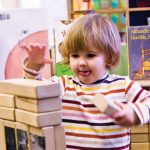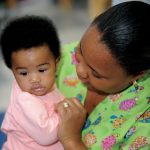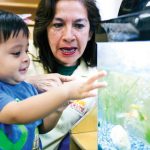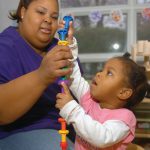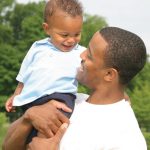The Illinois Early Learning Guidelines for Children Birth to Age 3 provide early childhood professionals and policy makers a framework for understanding child development by presenting information on what children know and should do and what development looks like in everyday life. The main goal of the Guidelines is to offer early childhood professionals a cohesive analysis of children’s development with common expectations and common language. These Guidelines also provide suggestions and ideas on how to create early experiences that benefit all children’s learning and development.
The Newborn Period
Self-Regulation: Foundation of Development (Introduction)
Developmental Domain 1: Social & Emotional Development (Introduction)
Developmental Domain 2: Physical Development & Health (Introduction)
Developmental Domain 3: Language Development, Communication, & Literacy (Introduction)
Developmental Domain 4: Cognitive Development (Introduction)
Approaches to Learning (Introduction)
Introductory Letter
Dear Reader,
It is with great pleasure that we present you with the Illinois Early Learning Guidelines for children from birth to three years of age. These Guidelines are the product of two years of intensive labor by many individuals and organizations. We have all focused on building comprehensive developmental learning standards for our youngest learners that form the foundation for all learning and development that is to follow. The myriad stakeholders involved in this project were driven by the following intentions for the use of the Guidelines:
- We hope the Guidelines speak to you, putting into words the development you see occurring each day with children from birth to three
- We hope the Guidelines support you in understanding and discussing child development
- We hope the Guidelines make you better equipped to plan for intentional interactions with children from birth to three
- We hope the Guidelines strengthen your commitment to responsive, developmentally appropriate practice with young children
- We hope the Guidelines enhance your belief system around the individual nature of the developmental trajectory and the crucial role that family and context play in each child’s development
We have had the honor of guiding a process to develop Early Learning Guidelines for birth to three that embody an approach that is responsive to our state early childhood infrastructure’s work and current needs in this area. In this project guidance and management role embedded within the Illinois Early Learning Council, we were able to draw out the best of our colleagues and stakeholders in the areas of knowledge, practice, and cross-system strategizing. Through this work we were establishing a shared set of beliefs around what children from birth to three should know and be able to do and what our responsibility is to seeing these outcomes for children.
Over the course of the two year project term, we asked a lot of everyone involved, and ourselves, and found that a shared commitment to young children drove us to push for the highest quality set of developmental guidelines. Inherent to our definition of quality was the need for this work to cut across all the service systems and sectors serving children from birth to three and their families. Each of these systems and sectors has had a hand in the creation of the Early Learning Guidelines with a careful consideration of the role of this content in their work with children and families. We are eager to continue to learn from one another and support each other in implementing the Guidelines to improve the quality of services delivered to children and families.
With our sincerest thanks,
Jeanna M. Capito
Executive Director
Positive Parenting DuPage
Karen Yarbrough
Director, Policy Planning and Knowledge
Ounce of Prevention Fund
Acknowledgments
Thank you to Robert R. McCormick Foundation Board and staff for their generous support of the project with a commitment that demonstrates respect for the process and for the Illinois stakeholders, and, most significantly, a reverence for the importance of supporting children from birth to three years. The McCormick Foundation continues to be a valued partner in furthering development of a high quality early learning system for our youngest children.
Thank you to the Early Learning Guidelines Workgroup members for their substantial contribution of time to guide a process that never lost sight of children from birth to three, and to the Writing Team members for their tireless commitment to getting the content just right.
- Barbara Abel, University of Illinois at Chicago
- Jennifer Alexander, Metropolitan Family Services
- Vincent Allocco, El Valor
- Casey Amayun, Positive Parenting DuPage
- Jeanne M. Anderson, Nurse Family Partnership – National Office
- Gonzalo Arroyo, Family Focus – Aurora
- Anita Berry, Advocate Health Care
- Jill Bradley, Illinois Action for Children
- Sharonda Brown, Illinois State Board of Education
- Ted Burke, Illinois EI Training
- Stephanie Bynum, Erikson Institute
- Jennett D. Caldwell, Peoria Citizens Committee for Economic Opportunity, Inc.
- Jill Calkins, Tri-County Opportunities Council
- Alexis Carlisle, Department of Children and Family Services
- Lindsay Cochrane, Robert R. McCormick Foundation
- Kimberly Dadisman, Chapin Hall Center for Children
- Kathy Davis, Springfield SD 186
- Elva DeLuna, Illinois Department of Human Services
- Claire Dunham, Ounce of Prevention Fund
- Bridget English, Jacksonville SD 117
- Mary English, Jacksonville SD 117
- Jana E. Fleming, Erikson Institute
- Mary Jane Forney, Illinois Department of Human Services
- Phyllis Glink, The Irving Harris Foundation
- Julia Goldberg, Childcare Network of Evanston
- Pat Gomez, La Voz Latina
- Marsha Hawley, Kendall College
- Theresa Hawley, Educare of West DuPage
- Lynda Hazen, Head Start DuPage
- Artishia Hunter, Postive Parenting DuPage
- Jean Jackson, Community Child Care Connection, Inc.
- Raydeane James, Illinois State Board of Education
- Leslie Janes, Carole Robertson Center for Learning
- Jamilah R. Jor’dan, Jor’dan Consulting Group, Inc.
- Susan Kaplan, Illinois Association for Infant Mental Health
- Leslie Katch, National-Louis University
- Joanne Kelly, Illinois Department of Human Services
- Kathy Kern, Parenthesis, Inc.
- Ashleigh Kirk, Voices for Illinois Children
- Rebecca Klein, Ounce of Prevention Fund – Hayes Center
- Jon Korfmacher, Erikson Institute
- Linda Langosch, Community & Economic Development Association of Cook County
- Rima Malhotra, Chicago Public Schools
- Janet Maruna, Illinois Network of Child Care Resource & Referral Agencies
- Jean Mendoza, Early Childhood and Parenting Collaborative
- Paulette Mercurius, Chicago Department of Family and Support Services
- Susan R. Miller, Consultant
- Lauri Morrison-Frichtl, Illinois Head Start Association
- Heather Moyer, Teen Parent Connection
- Christina Nation, Parents as Teachers – Springfield School District
- Nara Nayar, Advance Illinois
- Kristie Norwood, Chicago Commons
- Sessy Nyman, Illinois Action for Children
- Gregory O’Donnell, Ounce of Prevention Fund
- Marcia Orr, Before and After School Enrichment, Inc.
- Patricia Perez, City Colleges of Chicago
- Christy Poli, Bensenville Birth to Three Program
- Rosaura Realegeno, Family Focus – Aurora
- Susan Reynolds, Chicago Public Schools
- Vanessa Rich, Chicago Department of Family and Support Services
- Kate Ritter, Illinois Action for Children
- Jessica Roberts, Voices for Illinois Children
- Celena Roldan, Erie Neighborhood House
- John Roope, Chaddock Child and Family Center
- Allen Rosales, Christopher House
- Gina Ruther, Illinois Department of Human Services
- Christine Ryan, Chicago Public Schools
- Andrea Sass, YWCA of Metropolitan Chicago
- Linda Saterfield, Illinois Department of Human Services
- Joni Scritchlow, Illinois Network of Child Care Resource & Referral Agencies
- Mary Self, Make A Difference – Bradley Elementary School District
- Cherlynn Shelby, Department of Children and Family Services
- Kathleen M. Sheridan, National-Louis University
- Heather Shull, Early Explorations, Inc.
- Julie Spielberger, Chapin Hall Center for Children
- Lauren Stern, El Valor
- Mary Lee Swiatowiec, Childcare Network of Evanston
- Barbara Terhall, Easter Seals Joliet Region, Inc.
- Dawn V. Thomas, University of Illinois at Urbana-Champaign
- Victoria Thompson, Children’s Home Association of Illinois
- Marsha Townsend, Illinois Department of Children and Family Services
- Sharifa Townsend, Illinois Action for Children
- Melissa Veljasevic, 4-C: Community Coordinateed Child Care
- Rebecca Waterstone, SGA Youth and Family Services
- Xiaoli Wen, National-Louis University
- Deb Widenhofer, Baby TALK, Inc.
- Candace Williams, Positive Parenting DuPage
- Katie Williams, U.S. Department of Health and Human Services
- Cass Wolfe, Infant Welfare Society of Evanston
- Janice Woods, Chicago Commons – New City
- Tweety Yates, University of Illinois at Urbana-Champaign
Over the course of this process, the Work Group has relied upon the input and lessons learned from numerous stakeholders within Illinois and from peers in other states. Thank you all for taking the time to guide us with your extensive feedback during interviews and conversations.
A total of 24 interviews were conducted; thank you to representatives from the following Illinois entities for their time and expertise:
- Advocate Healthy Steps for Young Children
- Chicago Department of Family and Support Services
- Erikson Institute
- Illinois Birth to Three Training Institute
- Illinois Chapter of the American Association of Pediatrics
- Illinois Children’s Mental Health Partnership
- Illinois Department of Children and Family Services Child Care Licensing
- Illinois Department of Human Services (IDHS), including the Bureaus of Child Care and Development, Child and Adolescent Health, and Early Intervention; the Head Start Collaboration Office; the Healthy Families Program; and Migrant and Seasonal Head Start
- Illinois Early Intervention Training Program
- Illinois Head Start Association
- Illinois Home Visiting Task Force
- Illinois Infant Mental Health Association
- Illinois Network of Child Care Resource and Referral Agencies
- IIllinois State Board of Education’s Early Childhood Division
- Kendall College
- Professional Development Advisory Council
- Western Illinois University
Thank you to the following states, representatives of which participated in in-depth interviews:
- California
- Kentucky
- Maine
- Nebraska
- North Carolina
- Pennsylvania
- South Carolina
- Washington
To our Illinois state agency partners, thank you for committing not only to the work of the creation of ELGs for birth to three but also to the longer term impact that will come from the implementation of this content across all programs in Illinois.
- Illinois Department of Child and Family Services
- Illinois Department of Human Services
- Illinois State Board of Education
Project management from the Ounce of Prevention and Positive Parenting DuPage thank the following individuals for being part of the team: Samantha Aigner-Treworgy, for project coordination and staffing; Barbara Dufford, our communications designer; Jessica Rodriguez Duggan, our technical writer; and Catherine Scott Little, national expert on early learning guidelines and processes to create them, for guidance on process design and review of the complete content.
Overall Introduction to the Guidelines
Children’s experiences in the first three years of life influence how they develop, learn, and interact with their world. This period is marked by an extraordinary amount of growth, and sets the foundation for children’s future learning and ongoing development.
The Illinois Early Learning Guidelines are designed to provide early childhood professionals and policy makers a framework for understanding development through information on what children know and should do, and what development looks like in everyday instances. These Guidelines also provide suggestions and ideas on how to create early experiences that benefit all children’s learning and development. The main goal of the Guidelines is to offer early childhood professionals a cohesive analysis of children’s development with common expectations and common language.
During the process of developing these Guidelines, core principles were taken into consideration. All of these principles are integrated into the Guidelines, providing a comprehensive and appropriate look at children’s development. The core principles are:
- Early relationships are most important and central to young children’s development.
- Development occurs across multiple and interdependent domains, in a simultaneous manner.
- Children develop and learn at their own unique pace and in the context of their family, culture, and community.
- Play is the most meaningful way children learn and master new skills.
Relationships
Early learning occurs in the context of relationships. Positive and secure relationships are the foundation for children’s healthy development in all areas and provide models for future relationships they will establish. These nurturing relationships give children the security and support they need to confidently explore their environment, attempt new skills, and accomplish tasks. Children who have strong, positive attachments with important adults in their lives use these relationships to communicate, guide behavior, and share emotions and accomplishments. These meaningful interactions and relationships are essential for children’s development as they help them realize they have a meaningful impact on their world and the people around them.
Domains of Development
Children’s development is looked at through four core developmental domains: social and emotional, physical, language, and cognitive. Children develop across these four domains at the same time, with each area of development dependent on growth in all the other areas. There may be times when children seem to focus on one particular area of development, while having little growth in another area. For example, a 12-month-old child who is concentrating on language may not display any interest in walking on his or her own. Then, a few weeks later, the child suddenly starts to walk. This is an example of how development flows, and while it may seem that they may “stall” at certain times, children are actually growing and learning in all of the areas at all times.
Influences on Development and Learning
Children follow a general continuum as they develop, and each child will reach his developmental milestones at his own individual pace, and through his own experiences and relationships. Development is influenced by various factors:
Culture
Culture plays a significant role in how children develop, as it influences families’ practices, beliefs, and values for young children. Goals for children’s learning and development differ across cultures. Therefore, it is important for early childhood professionals to know, recognize, and respond sensitively to the multitude of cultural and linguistic variations that families and children exhibit. In order to support healthy development, it is important to provide culturally appropriate activities and experiences that are responsive to children from diverse backgrounds.
Toxic Stress
Stress is a common experience for all children. While positive and tolerable stress – such as moving to a new neighborhood, or parental separation or divorce – is all part of healthy development, toxic stress is detrimental to the developing child. Toxic stress includes physical or emotional abuse, chronic neglect, extreme poverty, constant parental substance abuse, and family and community violence.3 Toxic stress is attributed to prolonged activation of children’s stress systems, without support or protection from caregivers. 4 Extended and repeated exposure to these stressors disrupts children’s brain development and impacts their overall development, with the possibility of lifelong negative health issues. However, because the brain is still growing during the first three years of life, the effects of toxic stress can be buffered and even reversed through supportive and responsive relationships with nurturing adults.5
Differences in children’s learning abilities
Children have varying developmental abilities and different learning styles that influence when and how they reach their developmental milestones. All children are unique and these differences are to be taken into consideration when caring for them. The structure of the learning environment should be tailored to varying abilities, and interactions between children and caregivers should be meaningful and appropriate. It is important to encourage acceptance and appreciation of differences in learning abilities and to partner with caregivers to align individual goals for children.
Temperament
Temperament refers to the unique personality traits that children are born with. Temperament influences how children respond to the world around them, and how others will interact with them.1 Some children are outgoing and assertive and love to try new things. Other children are slower to warm up and need time and support from adults to engage in new activities. Adults need to be sensitive to children’s temperament and interact with children in a manner that supports their temperament to foster feelings of security and nurturing.
Birth order
Birth order can influence children’s personality and how they relate with their family. Children each have their own unique personality traits; yet, birth order may have an impact on how children’s personality traits are expressed. For example, middle children may be more out-going and social because they have experience interacting with an older sibling. Or, youngest children may be more persistent because they may have to work harder for uninterrupted attention.2 These examples may not be consistent across all children, but it is important to note that all children have unique personalities that influence how they interact and develop. Birth order also impacts the caregiver’s role and how they parent and interact with each child. For example, there may be differences in how a caregiver approaches their youngest child, compared to their oldest child, due to increased confidence in their parenting skills.
Differences in abilities, language, culture, personality, and experiences should not be seen as deficits, but instead, be recognized as the unique characteristics that define who children are. The important goal early childhood professionals are tasked with during this age period is how to best support children’s diverse needs.
Play
Play is often described as “a child’s work”; it is central to how children learn and make sense of the world around them. Play is often spontaneous, chosen by the child, and enjoyable. Play consists of active engagement and has no extrinsic reward.6 It is very important to highlight that play does NOT include television watching or games played on the computer or other technology devices.
Children use play to learn about their physical world, themselves, and others. Children use play to sort out their feelings and explore relationships, events, and roles that are meaningful to them. Play changes drastically in the first three years. For example, a six-month-old plays with an object simply by touching and mouthing it, an 18-month-old purposefully makes an object move in a certain way, and a 34-month-old uses language and actions while playing with an object. This example demonstrates how play becomes more complex to match and meet children’s developing abilities.
Who, me? A professional brain developer?
Absolutely! Parenting children is the most important job and one of the most challenging. All caregivers are tasked with developing and shaping the brain of society’s youngest scientists. Brain development in the first three years is extraordinary. While children’s brains are not fully developed at birth, the early experiences in their lives influence the rapid growth and development of their brain. Positive and nurturing interactions and experiences promote neural connections in the brain, which are essential for healthy development and growth.7 Caregivers are not only forming how children think through consistent, nurturing, and responsive care; they are also building the foundation for how children learn and interact with their world.
Who are the professional brain developers? Any person who is responsible for the care of children!
Within the Guidelines, there are varying references to caregivers, familiar others, attachment figures, and primary caregiver(s). All of these people impact children’s brain development. Below is a brief description of each:
- Caregivers and Primary Caregivers include those who are primarily responsible for the care of the child. Caregivers can include parents, grandparents, relatives, and childcare providers.
- Attachment figures, a term used in the Social and Emotional domain, refer to a few, select caregivers with whom children have an attachment relationship. Attachment figures can include parents, grandparents, relatives, and childcare providers.
- Familiar others are people who are a common presence in the life of the child. These may include family members, additional childcare providers, other birth-to-three professionals working with the family, family friends, occasional caregivers, and neighbors.
Within the Real World Stories and Strategies for Interactions, there are examples and suggestions for how caregivers can promote healthy brain development in young children.
Notes
- Brazelton, T. B. (1992). Touchpoints: Your child’s emotional and behavioral development. New York: Perseus.
- Shulman, Bernard H. & Mosak, Harold H. (1977). Birth order and ordinal position. Journal of Individual Psychology, 33(1), 114–121.
- National Scientific Council on the Developing Child. (2007). The Science of Early Childhood Development: Closing the Gap Between What We Know and What We Do (pp. 9–11).
- National Scientific Council on the Developing Child. (2007). The Science of Early Childhood Development: Closing the Gap Between What We Know and What We Do (pp. 9–11).
- National Scientific Council on the Developing Child. (2007). The Science of Early Childhood Development: Closing the Gap Between What We Know and What We Do (pp. 9–11).
- Class Lecture, Erikson Institute (2002). Course: Cognition, Language, and Play. Professor Jie-Qi Chen, Ph.D. Chicago, Ill.
- Hawley, Theresa, Ph.D. (2000). Starting Smart: How Early Experiences Affect Brain Development. Zero to Three.
Development of the Guidelines
The Illinois Early Learning Guidelines were developed in collaboration with key Illinois stakeholders in the infant-toddler field. Early childhood leaders, educators, practitioners, and policy experts came together to ensure the creation of an accessible and user-friendly document, presenting evidence-based and up-to-date information on infant-toddler development for parents, caregivers, early childhood professionals, and policy makers. The structure of the group stemmed from the Illinois Early Learning Council—Infant Toddler Committee. Within this committee, a Workgroup formed to create the vision for the Guidelines. The vision of the group was to ensure a document that could align with and integrate into the complex system of services for children birth to three in the state, and fulfill the ultimate goals of improving program quality, growing provider capacity, and strengthening the current systems.
The leadership group of the Workgroup then began coordinating the development of the Guidelines, with input from the Workgroup and from the six writing teams, which were small sub-groups of the Workgroup. The writing teams were tasked with providing input and review of developmentally appropriate content. This collaborative approach in writing the Guidelines allowed for important decisions to be made by a diverse range of professionals representing different areas of the field. This collaboration resulted in the creation of Guidelines that:
- Create a foundational understanding for families, providers, and professionals in the field of what children from birth to age three are expected to know and do across multiple developmental domains.
- Improve the quality of care and learning through more intentional and appropriate practices to support development from birth to three.
- Develop a more qualified workforce.
- Enhance the current system of early childhood services by aligning birth-to-three developmental standards with existing standards and practices for older children and across system components.
- Serve as a resource for those informing decision makers involved with developing and implementing policies for children from birth to three.
The Guidelines are NOT intended to replace any existing resources that are currently used in birth-to-three programs and are not an exhaustive resource or checklist for children’s development. The Guidelines are NOT a:
- Curriculum
- Program model
- Developmental Screening Tool
- Developmental Assessment Tool
- Professional Development Curriculum
The Guidelines are designed to complement these educational tools and provide a cohesive analysis of children’s development with common expectations and common language.
How to Use the Guidelines
The Guidelines begin with The Newborn Period, which discusses the first four months of children’s lives and the experiences that are unique to this time. The first of the six sections, Self-Regulation: Foundation of Development, focuses on children’s development of self-regulation, which is essential for overall healthy development and learning. Self-Regulation refers to children’s emerging ability to regulate or control their attention, thoughts, emotions and behaviors.1 Next, Domains of Development are specific areas of growth and development. The Guidelines consist of four developmental domains: Social and Emotional Development; Physical Development and Health; Language Development, Communication, and Literacy; and Cognitive Development. The final section, Approaches to Learning, focuses on specific methods by which children engage with the world around them in order to make meaning and build understanding of their experiences. These six sections are each structured in the same manner and are further broken down into Sub-Domains/Sub-Sections, Standards, Age Descriptors, Indicators for Children, and Strategies for Interaction.

These six sections include five different components:
- Sub-Domains/Sub-Sections are detailed components of each developmental domain or section, such as “Empathy” under Social & Emotional Development (domain 1).
- Standards are the general statement of what children should know and be expected to do by the time they reach 36 months of age.
- Age Descriptors describe the progression of development for each of four particular age groups across the birth-to-three age range. These four distinct and overlapping groups are: Birth to 9 months, 7 to 18 months, 16 to 24 months, and 21 to 36 months (see Figure 1 above). These age groupings are used in order to reflect children’s bio-behavioral shifts, which are changes in behavior triggered by biological changes in the brain. These shifts allow children to grow and gain new skills.
- Indicators for Children are some of the observable skills, behaviors, and knowledge that children demonstrate to “indicate” progress toward achieving the standard.
- Strategies for Interaction are specific activities, practices, and interactions in which caregivers can engage with children to support healthy development.
Real World Stories are real-life examples that demonstrate the specific concepts of development in action.
Keep in Mind lists behaviors that can be used to identify possible concerns for development and are found at the end of the Self-Regulation section, and the four developmental domains section.
Interconnections
Since development occurs across multiple, inter-related areas, readers will see a short list of other, closely related sub-domains/sub-sections in every sub-domain/sub-section introduction and in each real world story. While every sub-domain and sub-section can relate to the others, the Guidelines highlight those most relevant to each particular one. At right is an example.
Notes
- Shonkoff, J. & Phillips, D. (Eds.). (2000). From neurons to neighborhoods: The science of early childhood development. Washington, D.C.: National Academy Press. Online version
Horizontal Alignment
Where Do the Illinois Early Learning Guidelines Fit into the Fabric of Birth-to-Three Programs and Service Systems?
Horizontal alignment demonstrates how developmental guidelines are interconnected with the implementation of program components across a multitude of service systems. The Early Learning Guidelines are intended to support and enhance the ability of professionals to implement program curriculum, program standards, and child assessment. This implementation should be appropriate to the given service delivery type, model, or mechanism, through programs such as home visiting, child care, early intervention, and others.
Rather than replace any of the essential components for implementing high-quality programs for infants and toddlers, which include curriculum, program standards, and assessments, the Guidelines fit into a coherent framework and are aligned with these essential components. All the elements are nested in a system of professional development.
These guidelines were designed to support infant-toddler practitioners regardless of program setting. The developmental progression of what children should know and be able to do within stages outlined in this document are the same for all children, taking into consideration individual developmental needs and trajectory, and apply irrespective of the settings in which children are being cared for.
When all practitioners responsible for this care are operating from the same base of knowledge and speaking from the same “play book,” we will be able to create a more unified language amongst those practitioners. This will help practitioners engage with the parents and each other around developmentally appropriate expectations for learning and growth in children.
How Supports for Quality Programming Fit Together
- Early Learning Guidelines describe what children should know and be able to do along a continuum, including indicators to help show how development can be seen in everyday behavior. Guidelines, age descriptors, and indicators are based in the extensive child development research literature. The Illinois Early Learning Guidelines provide practitioners with a “line of sight” for development in the first three years of life, describing how children progress along the developmental trajectory.
- Curriculum helps outline how practitioners go about teaching young children and supporting their development in their practices. Curriculum is usually designed for the specific setting or program type (e.g., home visiting, center-based early care and education, etc.). Research-based curricula are rooted in the same developmental science underlying the growth and learning expectations described in these guidelines.
- Child Assessments are a way to measure and understand where children are along a developmental continuum and can help to identify where developmental learning needs to be further supported. Assessments are also rooted in the same science describing what children should know and be able to do that informs this document. Specific assessments tie into some curricula, while other assessments can be used independently across curricula.
- Program Standards describe required structural elements of specific programs that need to be in place to achieve stated program goals. These are frequently determined by program funders or models, and can include requirements such as specific ratios and/or group sizes, teacher/practitioner qualifications and/or training, and the use of a research-based curriculum. The Illinois Early Learning Guidelines can be implemented in conjunction with program standards through requirements such as specific trainings on the guidelines.
How Implementation Happens
Implementation of the Illinois Early Learning Guidelines happens as practitioners become better acquainted with the knowledge of development in the first three years of life, using it as they do the work of program implementation, and ultimately interacting with young children and their families.
To this end, professional preparation and pre- and in-service training and technical assistance systems play a critical role in quality implementation of these Guidelines. Training on the Guidelines must be tailored to professionals based on the context of the setting in which they are delivering services. The Guidelines must also be integrated into ongoing professional development and coaching at all levels, so that program leaders can support staff in embedding developmentally appropriate practices throughout all their work.

Vertical Alignment
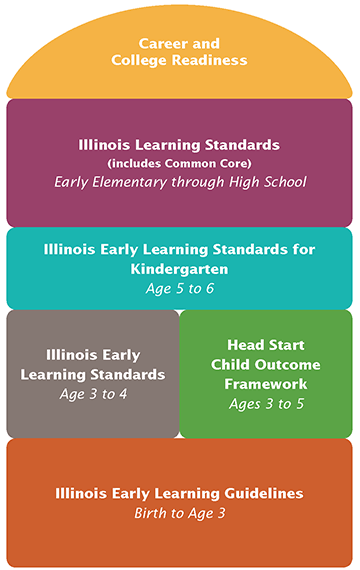
Illinois Early Learning Guidelines: The Foundation for Later Learning
The growth that happens in the first three years of life lays the foundation for later learning; therefore it is important to consider the alignment of the Early Learning Guidelines with the learning standards and guidelines for children in older age groups. Vertical alignment refers to the process of ensuring guidelines for one age period are in sync with guidelines from the age periods that come before it and/or those periods that follow after.
An understanding of the learning and growth from birth to three is fundamental to understanding and supporting the growth and development expected in all future age periods. In general, while the Standards and Guidelines for the younger ages are more oriented toward a developmental approach to learning and growth, standards for the K–12 period become more oriented toward academic or subject matter content.
Ensuring “vertical” alignment was a priority throughout the development of these Guidelines. This was done through content configuration and the careful consideration of age appropriate indicators. The content of the Early Learning Guidelines outlines growth and development from birth to age three and is the essential building block upon which all other development progresses.
Just as the domains of development cannot be fully detangled from one another, the learning that happens within a specific domain of the early learning guidelines for children birth to three informs learning and development beyond any one other specific domain in the learning standards for later ages. For example, while there is a direct correlation between language development happening from birth to three years and the fulfillment of the Language Arts benchmarks outlined in the Illinois State Board of Education’s standards for Kindergarteners, the acquisition of language that happens in the first three years of life allows for all learning that happens subsequently far beyond those specific benchmarks for Language Arts—including, at minimum, Math, Science, Social Studies, Fine Arts, and Foreign Language.
In Illinois, the guidelines and standards in place for children from three to four years old include the Illinois Early Learning Standards and the Head Start Child Outcomes Framework. Next, vertical alignment considers the Illinois Early Learning Standards for Kindergarten and the content areas covered by these standards, which are designed for children age five and six. Following these standards are the Illinois Learning Standards that cover elementary through high school and include Social Emotional Learning, and the Common Core Standards.
Illinois Learning Standards, including new Common Core Standards (Early Elementary through High School)
- Fine Arts
- Foreign Language
- Language Arts (Common Core K–12)
- Mathematics (Common Core K–12)
- Physical Development and Health
- Science
- Social Science
- Social Emotional Learning
Illinois Early Learning Standards for Kindergarten (Age 5 to 6)
- Fine Arts
- Foreign Language
- Language Arts
- Mathematics
- Physical Development and Health
- Science
- Social/Emotional Development
- Social Science
Head Start Child Outcome Framework (Age 3 to 5)
- Approaches to Learning
- Creative Arts
- Language Development
- Literacy
- Mathematics
- Physical Health and Development
- Science
- Social and Emotional Development
Illinois Early Learning Standards for 3- to 4-Year-Olds (Age 3 to 4)
- Fine Arts
- Foreign Language
- Language Arts
- Mathematics
- Physical Development and Health
- Science
- Social/Emotional Development
- Social Science
Illinois Early Learning Guidelines for Children Birth to Age 3 (Birth to age 3)
- Approaches to Learning
- Cognitive Development
- Language Development, Communication, & Literacy
- Physical Development & Health
- Self-Regulation
- Social & Emotional Development
Glossary
A
- Alignment refers to how these early learning standards relate to the sets of standards in place for older children. It also illustrates the interconnectedness of these standards within state systems and early childhood programs, producing healthy outcomes.
- Attachment figures refer to a few, select caregivers, with whom children have an attachment relationship. Attachment figures can include parents, grandparents, relatives, and childcare providers.
- Attachment refers to the bond between a child and their primary caregiver(s). The secure attachment relationship provides emotional and physical security for the child, and is the foundation for development and learning.
- Attending refers to children’s ability to remain focused on objects and people for brief periods of time. As they get older, children can attend, or remain engaged, for longer periods of time.
- Attention is the ability to focus and concentrate on something in the environment.
- Attributes are characteristics or properties of objects, such as shape, color, or size.
B
- Bio-behavioral shifts are changes in behavior triggered by biological changes in the brain. These shifts allow children to grow and gain new skills.
- Biological rhythms are patterns that occur within people’s bodies. These include sleeping, waking, eliminating, and maintaining normal body temperature.
C
- Caregivers are those who are primarily responsible for the care of the child. Caregivers include parents, grandparents, other relatives, and childcare providers.
- Causation refers to the relationship between cause and effect. Children understand that specific actions and words affect objects and people in their environment.
- Code-switching is the practice of moving back and forth between two languages within the same dialogue or conversation.
- Concept refers to a general notion or an abstract idea formed in the mind, derived from specific occurrences. Early experiences form schemes, which form into concepts.
- Co-regulator refers to the child’s primary caregiver(s) who assist the child in achieving regulation through responses, interactions, and communication.
- Cultural variations refer to the differences in beliefs, practices, and attitudes within the same cultural group.
- Culture consists of the beliefs, behaviors, objects, and other characteristics common to the members of a particular group or society.
- Curiosity is an instinctive drive to learn about the world.
D
- Delayed imitation occurs when a child imitates an action after a significant amount of time has passed.
E
- Early literacy encompasses the foundation for reading and writing.
- External states refer to what the environment demands, such as sounds, actions, touch, or objects.
F
- Familiar others are people who are a common presence in the life of the child. These may include family members, additional childcare providers, family friends, occasional caregivers, and neighbors.
- Fine motor refers to the movement and coordination of small muscles, such as those in the hands, wrists, and fingers.
G
- Gaze aversion is the child’s purposefully looking away and avoiding eye contact.
- Gross motor refers to the control and movement of large muscle groups such as the torso, head, legs, and arms.
H
- Habituation refers to becoming accustomed to and not distracted by stimuli occurring in the environment.
- Homeostasis refers to the infant’s ability to remain regulated and form basic cycles of sleep, wakefulness, feeding, and eliminating.
I
- Intentional or goal-directed behaviors are purposeful and deliberate. Intentional behaviors become increasingly complex as children grow.
- Internal states refer to bodily conditions, such as hunger, discomfort, or tiredness.
J
- Joint attention is the shared experience of looking at an object, person, or event, established by pointing, gesturing, or the use of language and/or vocalizations.
L
- Large muscles refer to the muscles found in the arms and legs. Large muscle movements include crawling, kicking, walking, running, and throwing.
- Linguistic variations are slight differences within a language and/or dialect.
O
- Object permanence refers to children’s understanding that objects continue to exist even though they can no longer be seen or heard.
- Object properties are observable characteristics that define objects. Examples of object properties include: size, weight, shape, color, and temperature.
- Overstimulation refers to excessive sounds, textures, temperatures, and sights that impede children’s ability to make a meaningful connection with others or objects.
P
- Perceptual development refers to taking in and interpreting sensory stimuli; it is through these stimuli that children learn about and interact with their environment.
- Persistence is the ability to see a process through in order to accomplish a particular goal. Children demonstrate persistence when they work through challenges to complete tasks and/or actions.
- Pincer grasp refers to grasping small objects with the index finger and thumb.
- Play is integral in how children learn about and make sense of their world. Play is enjoyable and spontaneous, and children use play to discover, pretend, and problem-solve.
- Private speech is children’s use of self-directed language to guide, communicate, and regulate their behavior and emotions. While this self-directed language can be heard, it is not intended for others.
- Proximity–seeking behaviors are those that the child uses to remain physically and emotionally connected to a caregiver, e.g., crawling over, making eye contact.
S
- Schemes are early frameworks that organize information and help infants make sense of their environment.
- Secure base behavior is described as the child’s ability to use their primary caregiver(s) as both a physical and emotional base while exploring their environment. This behavior emerges between seven and 18 months of age.
- Self-concept refers to the child’s developing ability in realizing that one’s body, mind, and actions are separate from those of others.
- Self-regulation is the ability to regulate or control attention, thoughts, emotions, and behaviors.
- Sensory stimuli are sounds, textures, tastes, sights, and temperatures found in children’s environments.
- Separation anxiety begins to occur between nine and 14 months and is expressed in tears, sadness, or anger when a child is physically separated from his or her primary caregiver(s).
- Small muscles refer to the muscles found in the hands, fingers, feet, and toes.
- Social referencing is the term for the way young children take their cues from familiar others in deciding what emotions and actions are appropriate.
- Soothe is the action of providing comfort and reassurance.
- Spatial relationships refer to where objects and people are located in space in relation to other objects and people, and how they move in relation to each other.
- Spontaneous refers to an action that is not preplanned.
- Stimulation refers to any number of sounds, textures, temperatures, tastes, and sights that impact a child’s senses or development.
- Stimuli are sounds, textures, tastes, sights, and temperatures found in children’s environments.
- Stranger anxiety is a normal part of development where children may cling to a familiar adult, cry, or look frightened when an unfamiliar person appears too soon or too close.
- Symbolic representation refers to children’s understanding of how an image or different objects can represent familiar objects.
T
- Telegraphic speech is known as the “two-word” stage and is the use of combining two words to convey meaning, e.g., “Daddy go.”
- Temperament refers to the unique personality traits that children are born with and that influence how they interact with their environment and with others.
- Textures refer to the different feel, appearance, and/or consistency of objects, surfaces, or substances.
- Toxic stress is detrimental to the developing child and includes exposure to physical or emotional abuse, chronic neglect, extreme poverty, constant parental substance abuse, and family and community violence.
- Transitions are changes in children’s activities or locations. Transitions are hard for young children, as they may feel out of control. Therefore, it is essential caregivers prepare children for transitions.
- Trial and error refers to a child’s use of different strategies while attempting to solve a problem.
- Tummy time is the time babies spend lying and playing on their stomachs while awake. This time is important for the development of head control and neck strength.
Additional Resources Used
Online Resources
Print Resources
- Bredekamp, S. (1987). Developmentally Appropriate Practice in Early Childhood Programs Serving Children from Birth Through Age 8. Language Development Handout. Washington, D.C.: National Association for the Education of Young Children.
- Segal, Marilyn, Ph.D. (1998). Your child at play. New York: Perseus.
- Wolf, D. & Gardner, H. (1979). Style and sequence in early symbolic play. In: N. Smith & M. Franklin (Eds.), Symbolic Functioning in childhood. Hillsdale, N.J.: Lawrence Erlbaum.
- Wyly, M. Virginia (1997). Infant Assessment. Boulder, CO: Westview Press.


